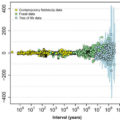
Human activities such as fishing and hunting are having astonishingly broad and swift impacts on the body size and reproductive abilities of fish and other commercially harvested species, potentially jeopardizing the ability of entire populations to recover, according to a new study in the Proceedings of the National Academy of Sciences.
Human predation, say the researchers involved, is accelerating the rate of observable trait changes by 300 percent above the pace observed within natural systems, and 50 percent faster than in systems subject to other human influences (such as pollution).
And the changes are not only fast, they are also dramatic in magnitude: harvested populations are on average 20 percent smaller in body size than previous generations, and their age of first reproduction is on average 25 percent earlier. “Harvested organisms are the fastest-changing organisms of their kind in the wild, likely because we take such high proportions of a population and target the largest,” said lead author Chris Darimont, of the University of California, Santa Cruz.
The study is the first to estimate the pace of evolution in commercially harvested organisms and compare the rates to other systems. The team calculated the rates of trait change with a metric appropriately called the “Darwin,” which allowed the comparison of changes across traits and species among natural and human-modified systems, including “human predator” systems.
“The public knows we often harvest far too many fish, but the threat goes above and beyond numbers,” said Darimont. “We’re changing the very essence of what remains, sometimes within the span of only two decades. We are the planet’s super-predator. The pace of changes we’re seeing supersedes by a long shot what we’ve observed in natural systems, and even in systems that have been rapidly modified by humans in other ways. As predators, humans are a dominant evolutionary force.”
Darimont’s findings also dramatically increase scientific understanding of the capacity of organisms to change. “These changes occur well within our lifetimes,” said Darimont. “Commercial hunting and fishing has awoken the latent ability of organisms to change rapidly.”
Some observed trait changes likely represent underlying genetic changes passed on from one generation to the next. In gill net fisheries, for example, evolution can favor smaller fish that pass through the mesh. Those smaller individuals are more likely to survive, reproduce, and pass on genes for smaller offspring, explained Darimont. By contrast, some trait changes likely do not involve genetic changes, a process called plasticity. For example, shifts to earlier reproduction can occur because of an abundance of food being shared by a much smaller population of fish. Whereas such plastic changes might be readily reversed if exploitation stops, this is likely not the case with genetic changes.
“Whatever the underlying process, shifts to earlier breeding spell trouble for populations,” said Darimont. “Earlier breeders often produce far fewer offspring. If we take so much and reduce their ability to reproduce successfully, we reduce their resilience and ability to recover.” As an example, Darimont cites commercial fishing that has devastated the number of Atlantic cod on the eastern coast of Canada, where cod used to first reproduce at the age of six years. They now reproduce at an average age of five years, a shift that occurred in less than two decades.
Ironically, some wildlife and fish management policies contribute to the rapid pace of trait changes. “Fishing regulations often prescribe the taking of larger fish, and the same often applies to hunting regulations,” said Darimont. “Hunters are instructed not to take smaller animals or those with smaller horns. This is counter to patterns of natural predation, and now we’re seeing the consequences of this management.” In Alberta, Canada, for example, hunters who are permitted to target the largest specimens of bighorn sheep have caused average horn length and body mass to drop by about 20 percent during the last 30 years.
“Although this is the first study of its kind, we assume this human impact is broad, because our predatory niche is so wide,” he said. “While wolves might prey on 20 animals, humans prey on hundreds of thousands of species.” In addition, researchers don’t know how these rapid changes will impact larger ecosystems, added Darimont. “Size really matters in nature, in terms of interactions with natural predators and competition for resources,” he said. “Will ecological links unravel as exploited species continue to rapidly shrink?”
“This should be a wake-up call for resource managers,” he added. “We should be mimicking natural predators, which take far less and target smaller individuals.” Commercial fisheries often take half a given population per year; by contrast, competing natural predators might take only 10 percent of a population, he added. However, more conservation-oriented policies would be no guarantee: “It’s unknown how quickly the traits can change back, or if they will,” noted Darimont. Finally, the results also sound an alarm about the viability of commercial industries. “By causing such abrupt and significant changes to their targets, many industries are harvesting away their future bounties,” he concluded.
Related:
Honey, We Shrunk The Cod
Fish Hatcheries Cause Stunning Loss Of Reproductive Fitness
Evolution Makes A Mockery Of Fishing Policy
Survival Of The Cutest








Comments are closed.